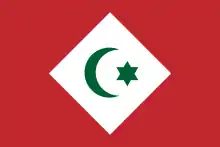Republic of the Rif
The Republic of the Rif (Berber: Tagduda en Arrif, Arabic: جمهورية الريف Jumhūriyya ar-Rīf), officially The Confederal Republic of the Tribes of the Rif, also recorded as the Riff, was a short-lived republic in northern Morocco that existed between 1921 and 1926. It was created in September 1921, when the people of the Rif revolted and declared their independence from Spanish occupation as well as from the Moroccan sultan Yusef.[1][2][3]
The Republic of Rif Tagduda en Arif جمهورية الريف | |||||||||
|---|---|---|---|---|---|---|---|---|---|
| 1921–1926 | |||||||||
 Flag
 Coat of arms
| |||||||||
.png.webp) Territory of Spanish Morocco under control of the Rif Republic (outlined in red) | |||||||||
| Capital | Ajdir | ||||||||
| Common languages | Riffian Berber Jebli Arabic | ||||||||
| Religion | Sunni Islam | ||||||||
| Government | Republic | ||||||||
| Head of State | |||||||||
• 1921–1926 | Abd el-Krim | ||||||||
| Prime Minister | |||||||||
• 1923–1926 | Hajj Hatmi | ||||||||
| Historical era | Interwar period | ||||||||
• Established | 18 September 1921 | ||||||||
• Disestablished | 27 May 1926 | ||||||||
| Currency | Rif Republic riffan | ||||||||
| |||||||||
| Today part of | |||||||||
Part of a series on the |
|---|
| History of Morocco |
 |
|
|
History
In 1921 Riffians under the control of Abd el-Krim crushed a Spanish offensive under General Manuel Fernández Silvestre at the Battle of Annual and soon after declared an independent republic on 18 September 1921. [4] The republic was formally constituted in 1923 with Abd el-Krim as Head of state and Ben Hajj Hatmi as Prime Minister.[5]
Abd el-Krim defeated the Spanish many times and drove them back to a few coastal outposts. He wanted to create a stable state for the Berbers to shield them from the long years of fighting. Abd el-Krim sent diplomatic representatives to London and Paris to try to establish diplomatic relations with Europe.
In late 1925, the French and Spanish created a joint task force of half a million men supported by tanks and aircraft.[6] From 1923 onwards, the Spanish used German-designed chemical weapons.[7] It was dissolved by Spanish and French occupation forces on 27 May 1926, after the long and bloody battles of the Rif War in which German-designed chemical weapons were used against the Berber populations by Spanish and French occupation forces but many Rif guerrillas continued to fight until 1927.[8]
References
- Day, Richard B.; Gaido, Daniel (2011-11-25). Discovering Imperialism: Social Democracy to World War I. BRILL. p. 549. ISBN 978-9004201569. Retrieved 14 September 2016.
- Wyrtzen, Jonathan (2016-02-19). Making Morocco: Colonial Intervention and the Politics of Identity. Cornell University Press. p. 183. ISBN 9781501704246. Retrieved 14 September 2016.
- Hall, John G.; Publishing, Chelsea House (2002). North Africa. Infobase Publishing. p. 62. ISBN 9780791057469. Retrieved 14 September 2016.
- David S. Woolman, Rebels in the Rif: Abd El Krim and the Rif Rebellion (Stanford University Press, 1968), p. 96
- "Morocco - The Spanish Zone". Encyclopedia Britannica. Retrieved 2020-08-11.
- Slavin, David H. (Jan 1991), "The French Left and the Rif War, 1924–25: Racism and the Limits of Internationalism", Journal of Contemporary History, 26 (1): 5–32, doi:10.1177/002200949102600101, JSTOR 260628, S2CID 162339547
- Rudibert Kunz: "Con ayuda del más dañino de todos los gases" – Der Gaskrieg gegen die Rif-Kabylen in Spanisch-Marokko in: Irmtrud Wojak/Susanne Meinl (eds.): Völkermord und Kriegsverbrechen in der ersten Hälfte des 20. Jahrhunderts, Frankfurt/Main 2004, pp. 153–191 (here: 169–185).
- "Abd el-Krim - Adb el-Krim during the Rif War". Encyclopedia Britannica. Retrieved 2020-08-11.
